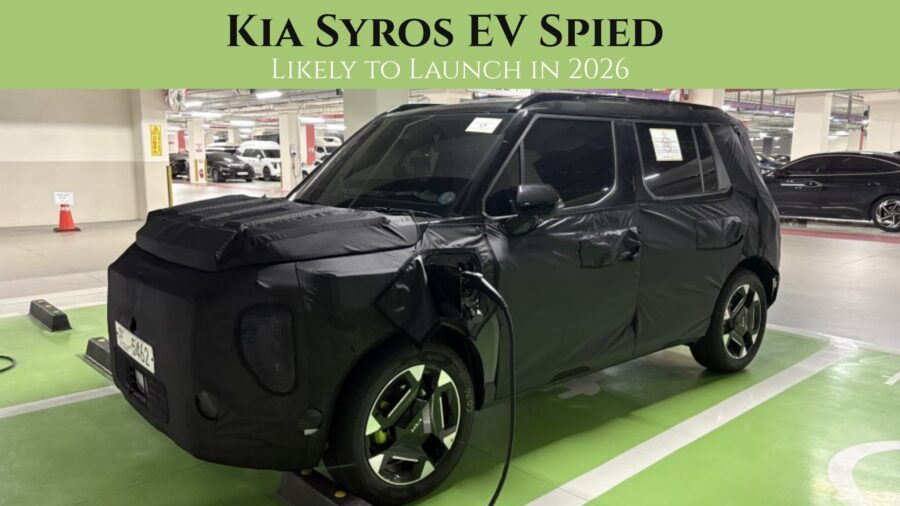What You Need to Know
- First spy shots reveal upright stance, sporty lime-green brake calipers, and front charging port
- Built on Hyundai Inster EV’s K1 platform
- Likely to offer dual 12.3-inch screens, ventilated seats, and Level 2 ADAS
- Expected price: ₹15–₹20 lakh | Launch window: Jan–Mar 2026
Introduction
The electric revolution in India’s compact SUV space just got a jolt of excitement — the Kia Syros EV has been spotted testing for the very first time. Set to debut between January and March 2026, this new electric SUV will sit alongside its petrol and diesel counterparts, giving buyers three powertrain choices under one nameplate. The spy shots don’t just confirm its existence — they also reveal several interesting design cues and hints about what’s under the skin.
Exterior Design – Familiar, Yet Electrifying
Despite the heavy camouflage, the Syros EV retains the upright stance and boxy silhouette of its internal combustion engine (ICE) sibling. The front fascia, although partially hidden, gives away key elements — including exposed headlights, a tall greenhouse above the beltline, and a radar unit integrated into the grille, confirming Level 2 Advanced Driver Assistance Systems (ADAS).
One detail that instantly catches the eye is the lime green brake callipers — a sporty touch usually reserved for Kia’s performance-focused GT models like the EV9 GT overseas. This could hint at a more spirited driving character compared to typical urban EVs. The charging port is positioned on the front right fender, making it convenient for varied parking situations.

Interior and Features – Comfort Meets Technology
While the spy shots don’t reveal the cabin, we expect the Syros EV to carry over most features from the ICE variant. That means dual 12.3-inch displays (one for infotainment, one for the instrument cluster), a panoramic sunroof, ventilated front seats, and reclining/sliding second-row seating for maximum flexibility.
On the safety front, expect a 360-degree camera, Level 2 ADAS suite, six airbags, and all-round parking sensors — essentials for both city driving and highway runs.
Battery, Motor, and Range – Borrowing Hyundai’s Tech
The Syros EV will share its K1 platform with the Hyundai Inster EV, which means two possible battery pack options: 42kWh and 49kWh. On the Inster EV, these deliver 300km and 355km WLTP-rated range respectively, so expect similar figures for the Syros. Power will be sent to the front wheels via a single electric motor, prioritising efficiency and city usability over all-wheel-drive performance.
Market Position and Sales Outlook
With an expected price tag of ₹15–₹20 lakh, the Syros EV will target urban families, fleet operators, and early EV adopters who want the practicality of a compact SUV with the running cost benefits of electric mobility. Kia is also banking on combined volumes from the Syros EV and the recently unveiled Carens Clavis EV, aiming for 50,000–60,000 units annually by 2026.
Kia Syros EV – Key Specs (Expected)
| Highlight | Why It’s Exciting |
|---|---|
| K1 Platform | Shared with Hyundai Inster EV – proven and reliable. |
| 42kWh / 49kWh Batteries | Choice between budget-friendly or longer range. |
| Range | About 300–355 km – ideal for city + weekend drives. |
| FWD Layout | Efficient and easy to live with in urban traffic. |
| Feature List | Big dual screens, ventilated seats, panoramic roof, ADAS. |
| Launch | Jan–Mar 2026 – not too far away. |
| Price Tag | ₹15–₹20 lakh – competitive for its segment. |
Final Word
The Kia Syros EV may not be a radical departure in design, but it’s shaping up to be a practical, feature-rich, and stylish entry into India’s fast-growing EV market. If Kia gets the pricing right and backs it with strong after-sales support, the Syros EV could easily become one of the most popular electric SUVs on Indian roads in 2026.
Image Source: Image of Kia Syros EV spy shots from AutoSpy

